Discover Bremen Traditions: Originals, Stories and Customs
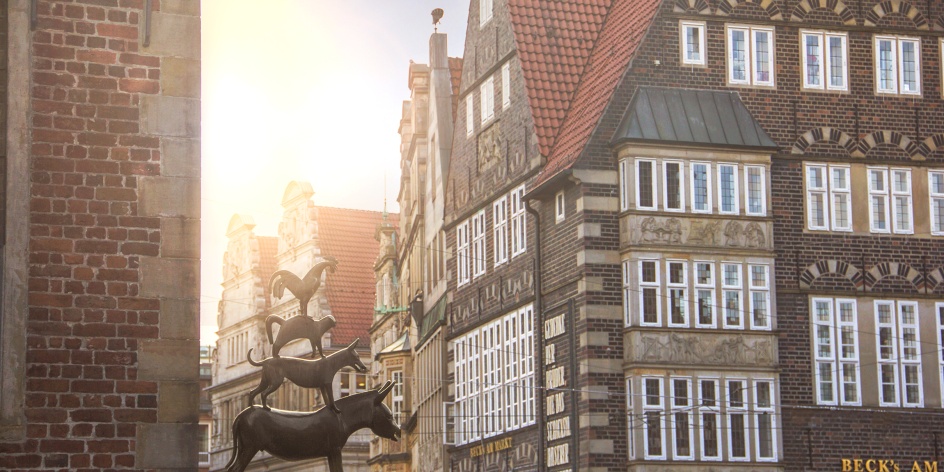
© WFB / Carina Tank
As a city, Bremen has a history that goes back thousands of years. Accordingly, numerous legends and myths entwine around historical personalities, buildings and landmarks. And also numerous, very own traditions are maintained in the Hanseatic city.
1. Eiswette (Ice Wager)
Although the Weser has not frozen over for decades, the people of Bremen still uphold the tradition of the Ice Wager every year on Epiphany Day: at 12 o'clock sharp, around 15 men dressed in black follow a 99-pound tailor to the "Punkendeich" (Osterdeich). The latter checks with a hot iron whether the Weser "goes or stands".
The bet is made among the so-called ice betting comrades. The winners of the bet can traditionally look forward to a community kale dinner, which the losers must host for a large company as part of a foundation feast on the third Saturday of January. The donations made at the feast go to the German Society for the Rescue of Castaways.
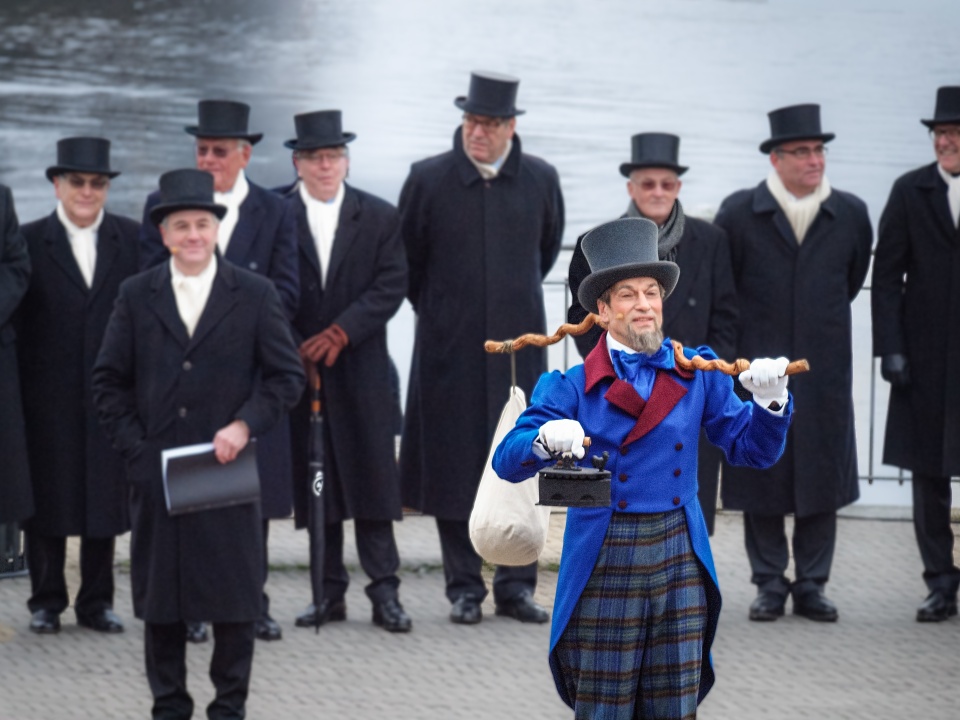
© WFB / Garner
2. Kohlfahrt (Curly Kale Tours)
As the first frost sets in, the season of curly kale starts in Bremen and the surrounding area, and with it the season of the traditional and festive curly kale tours! Numerous Bremen residents then make a pilgrimage through the city with a richly filled handcart, stopping at every opportunity for a schnapps. After the march, they eat a good portion of cabbage with potatoes, boiled sausage, smoked pork, pancetta and, of course, pinkel. What is pinkel, you ask? It's a coarse-grained, smoked sausage.
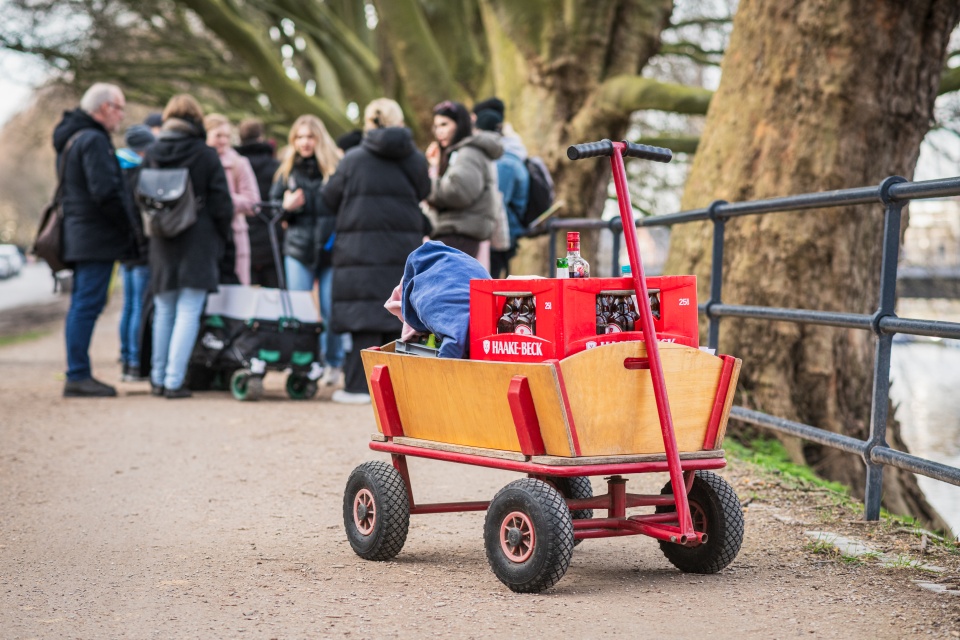
© WFB/Helms-Jacobs
3. Schaffermahl
For almost five centuries, the so-called Schaffermahl (a dinner) has been held annually in Bremen. As the oldest "Brudermahl" (brothers meal) in the world, it not only serves as an exchange between trade, shipping, industry and politics, but also raises funds for the Bremen foundation "Haus Seefahrt".
The course of the Schaffermahlzeit has always followed fixed traditions. In 2015, however, the time-honored festivity developed further in one respect: for centuries, only men were invited to the meal, which is why the event is increasingly coming under criticism. Having already invited a few female guests - such as Chancellor Merkel - the Schaffermahl now also regularly welcomes women.
4. Sweeping the Cathedral Stairs & Cleaning the Cathedral Door Handles
Many unmarried people have already cursed on their 30th birthday because they were ordered by families and friends to sweep stairs or clean door handles. In fact, this custom, which is slowly but surely spreading to other parts of Germany, originated in Bremen. In the Hanseatic city, it is usually St. Peter's Cathedral that has to have its steps and door handles cleaned.
5. Nikolauslaufen (St. Nicholas Run)
Nikolauslaufen (St. Nicholas Run)
As soon as it gets dark on December 6, St. Nicholas Day, groups of children dressed up set off from house to house or from store to store. They hurriedly recite Christmas poems and are rewarded with sweets and other small gifts.
The Nikolauslauf is named after St. Nicholas of Myra, a Greek bishop from the 4th century. He was known for his benevolence and generosity. The bishop is considered the patron saint of sailors, merchants and children. Therefore, it is believed that the custom of Sunnerklauslaufen goes back to cathedral and monastery students who, on special days, chose one of them to be the children's bishop. With him they then made a parade through the neighborhoods and also received food or small gifts.
6. Bremen Town Musicians
Probably the best known landmark of the Hanseatic city are the Bremen Town Musicians. Since 1953, a bronze statue by Gerhard Marcks on the left side of the town hall commemorates the popular fairy tale by the Brothers Grimm. According to the story, the donkey, dog, cat and rooster once set out for the city on the Weser to find a better life here. Although the four animals never quite made it to Bremen, today numerous visitors embrace the donkey's front legs every day to make a wish come true.
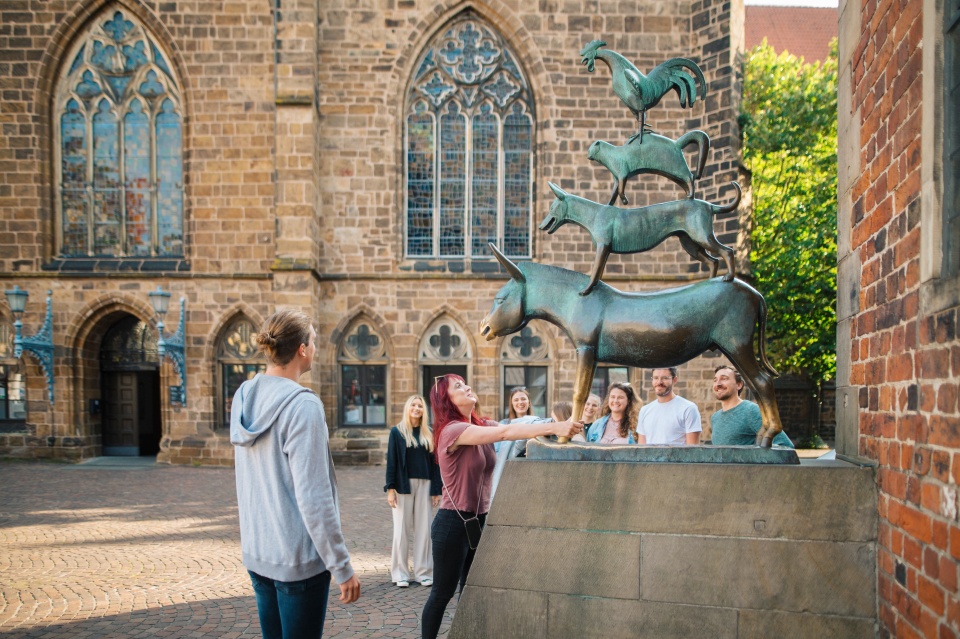
© WFB - Jonas Ginter
7. Heini Holtenbeen
The statue of one of Bremen's most eccentric characters in the peaceful Schnoor quarter. Strictly speaking, Heini Holtenbeen is not actually fictional. But this local character certainly became a legend in his own lifetime. Today, a bronze sculpture commemorates this Bremen character. Just around the corner from the statue, at the House of History in the Schnoor quarter, you can hear Heini Holtenbeen's anecdotes told by the man himself.
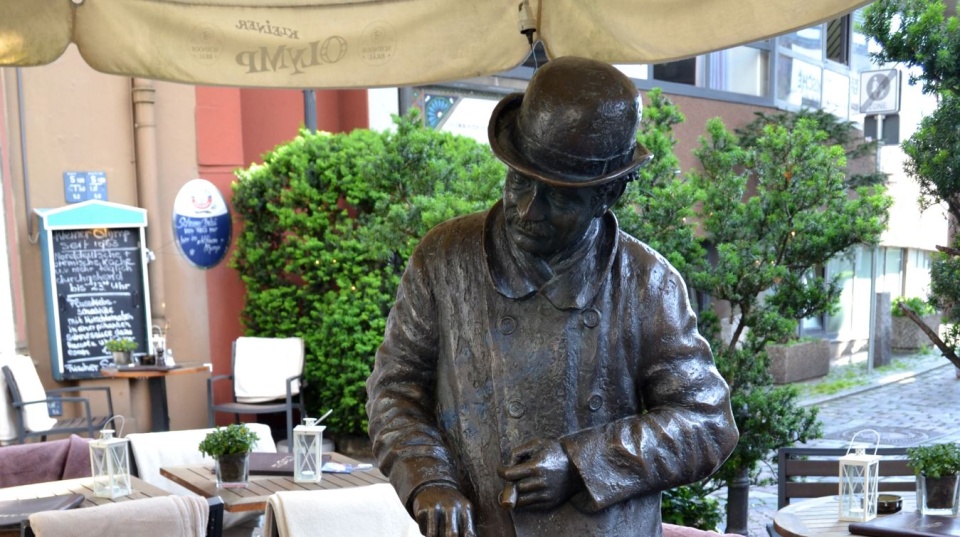
© bremen.online GmbH / MDR
8. The Legend of the Seven lazy Brothers
The Fountain of the Seven Lazy Brothers by Bernhard Hoetger is based on a local legend. The folk tale by Friedrich Wagenfeld tells the story of seven Bremen brothers who were not exactly known for their industriousness. Discredited as lazy, they found no work in the Hanseatic city, so they went out into the world. When they returned, they put into practice everything they had learned along the way that makes life easier: They built ditches and dams, paved roads and put in wells. Maybe a little lazy, but quite plietsch!
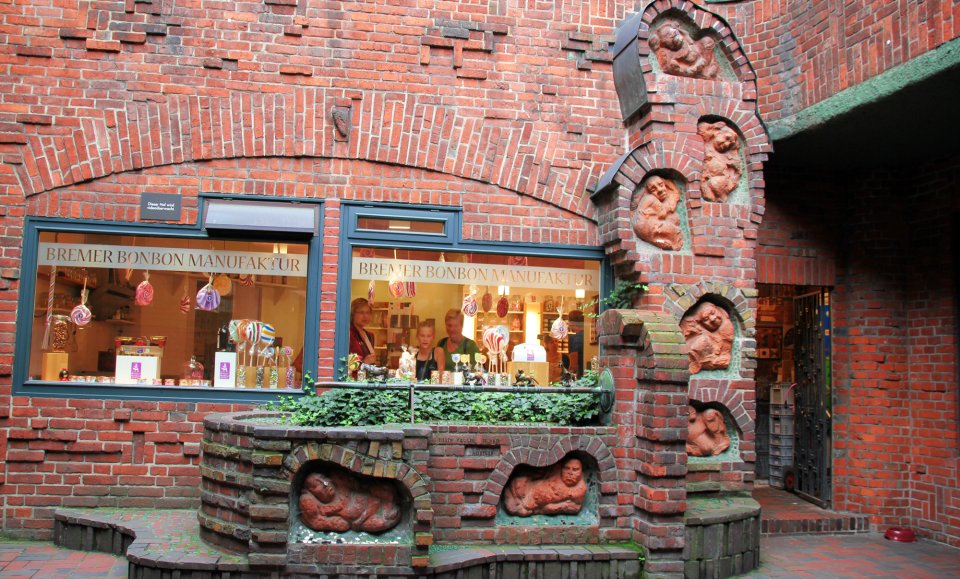
© bremen.online / KBU
9. Gesche Gottfried and the Spitting Stone
Gesche Gottfried wreaked havoc in Bremen between 1813 and 1828. The notorious poisoner killed 15 people with arsenic, including her parents, children and husbands. Her deeds did not go unpunished. Even today, a spitting stone in the Domshof marks the spot where Gesche Gottfried was executed on April 21, 1831. On a guided tour of the historic center of the city, you can track down the mysterious poisoner.

© Staatsarchiv Bremen
10. The Bleikeller (lead cellar) and the supposed Roofer
When the journeymen of the famous Arp Schnittgers were installing one of their master's organs in the cathedral in 1698, they accidentally discovered several mummies in the east crypt, which had been assigned to them as a working space. It is now known that the bodies at their place of discovery dried out naturally and mummified over time. For a long time, however, it was assumed in Bremen that lead, which had long been stored in the discovery room for the repair of the cathedral roof, was responsible for the mummification of the bodies lying there. A rumour persisted for at least as long that one of the mummies was a roofer who fell from the cathedral roof, was temporarily stored in the east crypt and forgotten there. But this legend has also been cleared up in the meantime: a bullet was found in the back of the mummy, so that it is now suspected that it was an officer who was shot in the Thirty Years' War or in one of the Swedish wars that followed in Bremen.
11. The Legend of the Bremer Gluckhenne
The legend of the Gluck hen and her chicks is Bremen's most famous folk tale and also the founding legend of the Hanseatic city. It is said to have been passed down orally for centuries until the Bremen legend writer Friedrich Wagenfeld recorded it in writing in the 19th century. According to the legend, some freedom-loving river fishermen were sailing along the Weser with their families, fleeing from ill-disposed neighbours. When a storm threatened to blow up, they were desperately looking for a place to stay. Then they discovered a hen with her chicks, who had found a safe place on the right bank of the river. The fishermen recognised this as a sign, for where a hen and her chicks were doing well, they too should be able to live well and in freedom, so they settled down and founded Bremen, "a haven of freedom".
Above the second arcade arch of the town hall, seen from the left, there is a monument to the hen and her chicks.
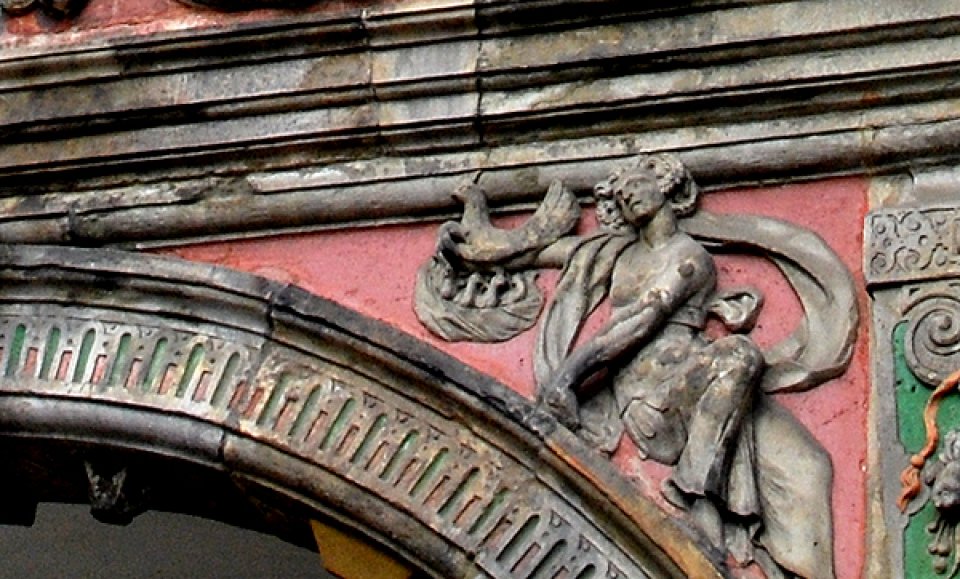
© privat / JUA
12. Countess Emma & the Cripple
Actually, very little is known about Emma von Lesum, who died in 1038. The woman, described as a charitable person, leaves all the more room for legendary stories. This is probably how the legend about the cripple, who has found his monument at the foot of the Bremen Roland, came about.
One day, Countess Emma, at the request of the citizens for pasture land, is said to have decided to give the people of Bremen as much of her land as a man could walk around in a day. Her brother-in-law, resentful and worried about his inheritance, trickily arranged for a cripple to set out. The countess dismounted from her horse and blessed the man, who could only move by crawling. He mustered all his strength, while the people of Bremen supported him with good words and food, so that by the end of the day he had circumnavigated an area worth seeing. Countess Emma kept her word and made the land available to the citizens, which they used from then on as a citizens' pasture.
The largest piece of the original citizens' pasture is now the municipal forest.
13. Fish Lucie
Fish Lucie, actually Johanna Lucie Henriette Flechtmann, lived from 1850 to 1921 and is the prime example of a Bremen woman who was as eloquent as she was resolute. As the daughter of a neustädter fishing family, she ran her own fish stall in front of the old stock exchange on Bremen's market square to feed her 16 children from two marriages. In order to get fresh fish as quickly as possible in the morning, she sailed her own boat to meet the incoming fishermen on the Weser. But this was not the only reason why Fisch Lucie quickly became a popular original. She was known above all for her quick-wittedness, which was usually expressed in her cheeky remarks. It was not uncommon for Lucie to use her fish as a weapon to defend or demand her rights. Today, Lucie Flechtmann Square in Neustadt is dedicated to her and is home to an urban gardening project.
14. Cathedral Mouse
The Town Musicians are not the only popular animals in Bremen. A little mouse has crept into St. Peter's Cathedral, which is almost as well known on the Weser as the donkey, dog, cat and rooster. The mouse can be found on the east choir of the cathedral at the foot of the portal on the right side wall, which dates from the second half of the 11th century.
Stories persist that the cathedral mouse was a sign of recognition for craftsmen. In fact, however, the mouse was a symbol for witches and devils in the Middle Ages and was supposed to banish evil and prevent them from entering the church.
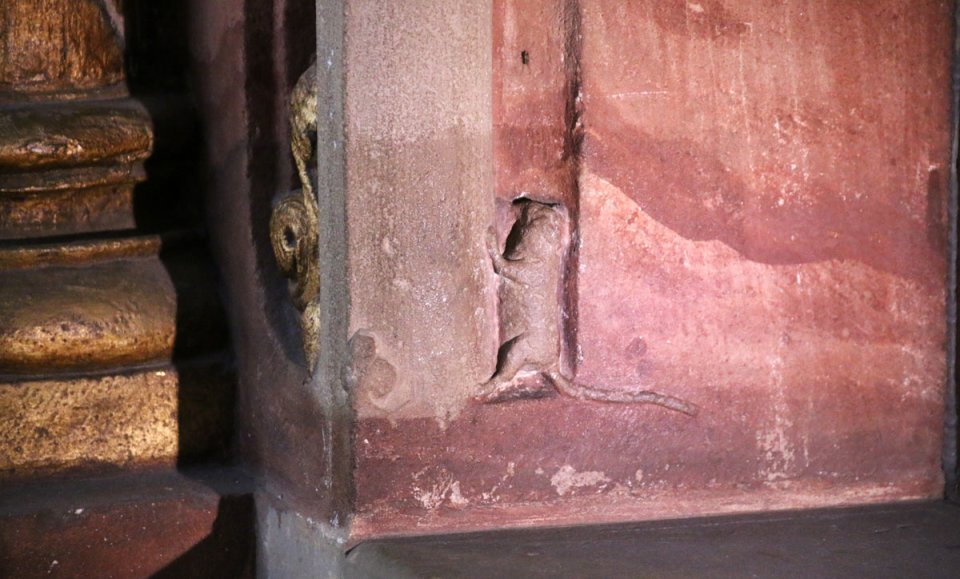
© privat / KBU
15. The Roland's Knee Tips & the Bremen Cubit
There are many legends surrounding the Roland statue in Bremen. One of them says that the distance between the two knee tips of Roland was once considered the yardstick of the Bremen cubit. In fact, the respective values are quite close: while the knee tips are about 55.4 centimetres apart, a Bremen cubit measures about 57.9 centimetres. In addition, marked measurements were often made available to the general public near marketplaces. However, there is no real proof of this.
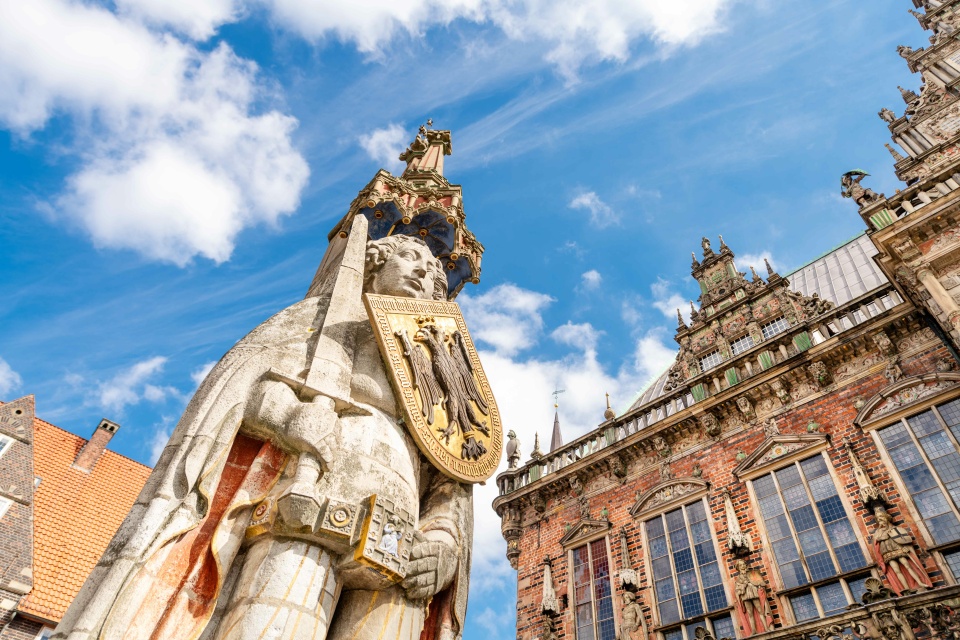
© WFB / Melanka Helms-Jacobs
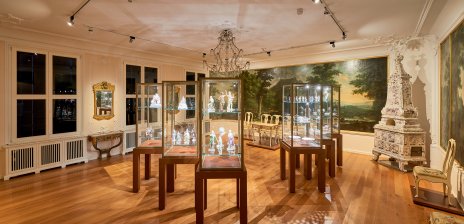
Bremen's Memory
For over 100 years, the Focke Museum has collected and preserved unique objects from Bremen’s history.
© Focke-Museum, Martin Luther
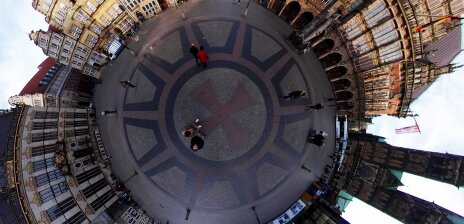
Take a Second Look at Bremen
There is so much history, and there are so many stories and places, that you might not know them all.
© WFB / MKA